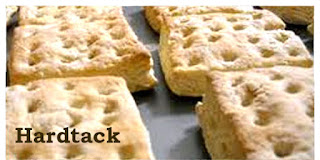The soldiers
gathered in small groups each evening to prepare their food. The food was low quality for both armies, but
the Confederate soldier suffered more from lack of food. For soldiers of the North, some food was obtained by plunder. When food deliveries were interrupted by weather delays or other challenges, soldiers were forced to forage the countryside to supplement their meager diets.
Yankee Soldier
Ingredients:
2 cups of flour
1/2 to 3/4
cup water
6 pinches of salt
Optional: add 1 tbsp of vegetable fat
Preheat oven to 400 degrees F. Mix the ingredients together into a stiff
dough, knead several times, and spread the dough out flat to a thickness of 1/4
inch on a non-greased cookie sheet. Using a knife, cut dough into 3-inch cracker
squares. Punch four rows of holes, four
holes per row, into each cracker.
Bake for 30 minutes. Remove from oven, turn
crackers over on the sheet and return to the oven and bake another 30 minutes.
Cool completely.
Many Southern soldiers simply cooked cornmeal mush around a rifle ramrod. They took the cornmeal and swirled it around in grease, making a dough. They then wrapped the dough around their rifle ramrod and cooked it over the campfire. That was called "sloosh".
Corn Pone
Corn pone was a staple of early settlers and Civil War soldiers.

Oatmeal pie recipe:

Idiot's Delight cake recipe:
An easy dessert to make, "Idiot's Delight" cake was quick and frugal. It was often served on Christmas and Holidays.
To learn more Civil War food recipes and learn the history of survival of women in the south...
Click here:
Brave southern women tell how they survived the desperate last days of the Confederacy in eyewitness accounts. They outwitted the plundering Yankees and fed starving children. Includes accounts of slave women. Civil War food recipes: cabbage stew, hoppin' John, oatmeal pie, Johnny cakes, molasses cookies etc. Amazon Best Seller.
Confederate Soldier
SlooshMany Southern soldiers simply cooked cornmeal mush around a rifle ramrod. They took the cornmeal and swirled it around in grease, making a dough. They then wrapped the dough around their rifle ramrod and cooked it over the campfire. That was called "sloosh".
Corn Pone
Corn pone was a staple of early settlers and Civil War soldiers.
Recipe
4 cups ground white or yellow cornmeal
1 tablespoon salt
2-3 cups of very hot (not boiling) water
1/4--1/2 cup bacon grease or other oil
Food on the Home front
1 tablespoon salt
2-3 cups of very hot (not boiling) water
1/4--1/2 cup bacon grease or other oil
In a large bowl,
add the hot water to the corn meal and mix into a thick batter. Cover with a
dishcloth and let it sit for 15 to 20 minutes. The batter should still be soft
enough to mold into a small cake.
Take
your cast iron skillet and put it over a medium heat on the stove or
over your fire, add the bacon grease or oil. When the oil is hot lay the cakes
into the pan. Cook them until they are browned on one side, this should take
about 3 minutes. Turn each and brown on the other side. Drain the fat and
serve.
source: https://preparednessadvice.com
Lacking many ingredients, the southern
women learned to alter food recipes according to their scarce available
resources.

Oatmeal pie recipe:
The military needed a cheap way to feed a lot of people, and soldiers across the country were introduced to the idea they could eat their horses' oats. So oats become a popular food. During the Civil War pecans were in short supply in the South, so oatmeal pie was a good substitute for southern pecan pie.

Idiot's Delight cake recipe:
An easy dessert to make, "Idiot's Delight" cake was quick and frugal. It was often served on Christmas and Holidays.
To learn more Civil War food recipes and learn the history of survival of women in the south...
Click here:
Brave southern women tell how they survived the desperate last days of the Confederacy in eyewitness accounts. They outwitted the plundering Yankees and fed starving children. Includes accounts of slave women. Civil War food recipes: cabbage stew, hoppin' John, oatmeal pie, Johnny cakes, molasses cookies etc. Amazon Best Seller.









